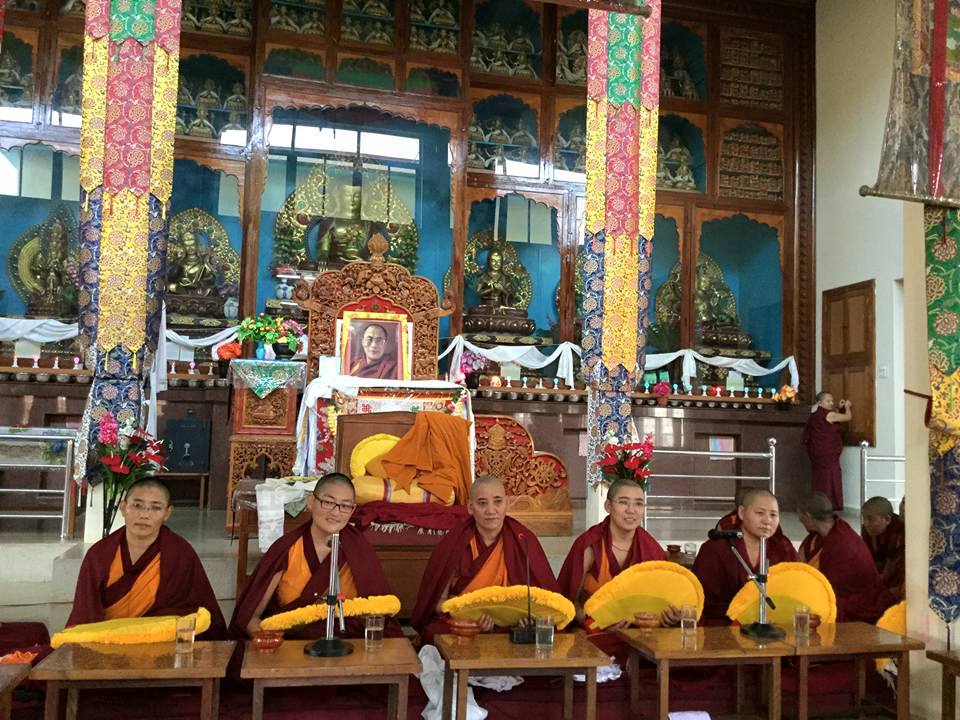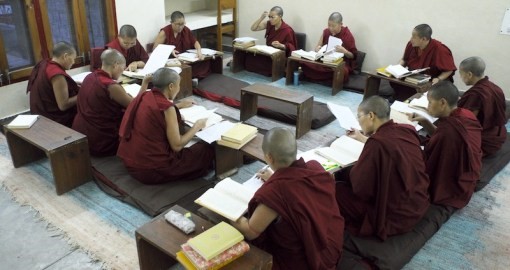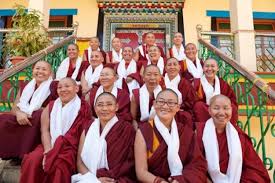 |
What is a Geshe ma Degree
In December 2016, for the first time in history, 20 Himalayan nuns were awarded the geshema degree, the highest philosophy degree in the Tibetan Buddhist tradition. This achievement is the culmination of efforts that began in the 1980s, but we are getting ahead of our story. To understand the monumental significance of this major breakthrough in women’s history, we first need to ask: What is a geshema degree?
The term geshema is the feminine equivalent of geshe, a degree in philosophy that was conferred at the three major monastic universities in Tibet – Drepung, Ganden, and Sera – which were exclusively male. It is unlikely that anyone was thinking about geshemas when the Buddhist School of Dialectics was founded in Dharamsala in 1973. As an educational experiment, the principal of the school, Lobsang Gyatso, set out to combine a traditional monastic curriculum and liberal arts education.
 |
The goal was to create an academic environment where young monks who had completed their secondary education could pursue the traditional curriculum in Buddhist studies. To prepare future generations of teachers, translators, and administrators, these students needed a solid Buddhist education as well as general knowledge, so they could present the Buddhist teachings in the language of the modern world. The challenge he faced was how to impart a profound knowledge of Buddhist texts – a project that might take great scholars a lifetime – with English, poetry, history, science, and other subjects. Students could then take the Geshe exams at a monastery in South India, if they liked.
The program in philosophy undertaken at the great monastic universities of Tibet is based on specific texts, studied in sequence.The initial text, Collected Topics, presents the tools of logic, followed by Mind and Reasoning, a text on Buddhist psychology. The study of these texts takes two years, accompanied by intensive daily debates. The next five years is spent studying Maitreya’s Ornament of Clear realization and Dharmakirti’s Pramana-vartika-karika to further develop the skills of analysis needed to fully understand Buddhist literature. Students who complete (survive!) these demanding studies then undertake a three-year detailed examination of the various schools of madhyamika philosophy. Following this, they study Abhidharma (higher knowledge) and Vinaya (monastic discipline). Altogether, the program takes at least twelve years.
 |
It was not until the 1980s that women gained access to systematic philosophical studies. Before then, the only option for women was to study with a private tutor, if she could find one. After a Western nun was allowed to study at the Buddhist School of Dialectics in the 1980s, a few monasteries for Himalayan nuns gradually began to offer similar programs. In time, the programs expanded and a new generation of scholar nuns started studying Buddhist philosophy and energetically debating it.
The twenty nuns who received the geshema degree in 2016 completed their studies at five monasteries in India and Nepal: Dolma Ling, Gaden Choeling, Jamyang Choeling, and Jangchub Choeling, and Khachoe Ghakyil Ling. Another six nuns received the degree in 2017. All these nuns received the same training as the monks and passed exams in the same subjects, administered under the auspices of the Ministry of Religion and Culture of the Central Tibetan Administration in Dharamsala.
Full ordination is still not available to nuns in the Tibetan tradition, so a special course in Vinaya studies was arranged for them. After completing their degrees, the geshemas began a systematic program of tantric studies. We join in expressing great appreciation for their dedication and accomplishments, confident that their Dharma studies will bring great benefit to them and their students. (This article was contributed by Akasha)
Some Short Facts About the Geshema Degree
- The Geshema Degree is roughly equivalent to a doctorate in Buddhist philosophy. For males, it is called the Geshe degree.
- It is the highest level of training in the Gelugpa school of Tibetan Buddhism.
- Until recently, this highest degree could only be earned by monks.
- In 2011, a German nun, Kelsang Wangmo, who spent 21 years training in India, became the first female to receive the Geshema title.
- The historic decision to confer the Geshema degree to Tibetan Buddhist nuns was announced in 2012 by the Department of Religion and Culture of the Tibetan Administration, following a meeting of representatives from six major nunneries, Institute of Buddhist Dialectics, and the Tibetan Nuns Project.
- Candidates for the Geshema degree are examined on the entirety of their 17-year course of study of the Five Great Canonical Texts.
- To qualify to sit for the Geshema exams and to begin the Geshema process, nuns must score 75% or above in their studies.
- On December 22, 2016, His Holiness the Dalai Lama awarded 20 Tibetan Buddhist nuns with Geshema degrees at a special graduation ceremony held at Drepung Monastery in Mundgod, South India.
Resources:
- Books describing the Tibetan monastic education system Include
- Georges B. J. Dreyfus, The Sound of Two Hands Clapping: The Education of a Tibetan Buddhist Monk
- (Berkeley: University of California Press, 2002);
- Michæl Lempert, Discipline and Debate: The Language of Violence in a Tibetan Buddhist Monastery
- (Berkeley: University of California Press, 2012);
- Daniel E. Perdue, Debate in Tibetan Buddhism (Ithaca, NY: Snow Lion Publications, 1992);
- Daniel Perdue, The Course in Buddhist Reasoning and Debate: An Asian Approach to Analytical Thinking Drawn from Indian and Tibetan Sources
- (Ithaca, NY: Snow Lion Publications, 2014);
- Katherine Rogers, Tibetan Logic (Ithaca, NY: Snow Lion Publications, 2009).

